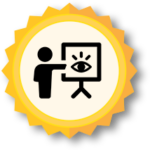Flipped Learning
 Overview and Introduction: The WHAT and WHO
Overview and Introduction: The WHAT and WHO
‘Flipped Learning’ is a pedagogical approach that changes the way students engage with their learning by reversing the order of the traditional lecture and assignment components of a course/unit/lesson. Traditional classroom models require students to participate in live lectures with an instructor, and then practice what they have learned through homework assignments. In the Flipped approach, instructors provide learning materials to access ‘outside’ of class time, and then use the class time for hands-on activities (e.g., practice exercises, problem-solving, workshop-style discussions, project collaboration) that enable students to apply the concepts in an interactive learning environment.
Students Benefits:
- ability to review information at their own pace
- more opportunities to interact with peers and the instructor, while working through challenging problems
- improvement of professional skills through collaborative learning
Instructor Benefits:
- more class time for solving complex problems through active learning
- opportunities to spot and correct misconceptions as students spend their class time applying concepts.
- ability to reuse materials

 Implementation and Timing: The WHEN, WHERE, and HOW
Implementation and Timing: The WHEN, WHERE, and HOW
Flipped Learning can occur for one lesson, one unit or a whole course. It really depends on the course objectives and the needs of the class. You can start with one lesson or a session that students tend to struggle with or that you as the instructor never have enough time to cover sufficiently. The key is to inform the students how the lesson/unit/course will work and set the expectations for study load outside the classroom.
Planning your Flipped Course or a Single Lecture
Adapting an entire course to a flipped model will require a steep initial investment of time. However, taking the time to create a repository of lecture content for your course will become an asset for future course iterations and the LTH has the resources to help you. Below is a process as well as sample questions to ask yourself as you consider this model.
- Analyze. Consider only flipping part of the course to begin. What topics do students struggle to understand? What concepts would students benefit from the opportunity to apply in the classroom where you could more carefully guide them? What is an activity that greatly benefits student learning that you rarely have time to complete during class?
- Design. What are the objectives for the course/unit/lesson? What activities would help students in the accomplishment of each objective? Where and how would each of these activities be best deployed? How are you going to prepare students for each interaction? Identify activities and plan your interactions for class sessions in advance. Use active learning strategies that have worked in your regular courses.
- Develop. Implementing the flipped classroom model calls for the creation of asynchronous self-study content for your students such as reading and viewing materials, online quizzes, interactive slide decks, and podcasts. Create and compile these resources to enable your design. For example, are you creating the videos or leveraging videos from another source? Have you created assignments for the Learning Management System? Consider embedding a few questions into the videos/slide decks to gauge student preparedness for in-class interaction. The LTH has resources to help you create interactive video-lectures, including self-recording from Screen Capture, self-service studios, to full multimedia production support and studios.
- Implement. Launch your plan. Explain to students why you are using a flipped classroom and how it will benefit them. Clearly convey your expectations.
- Reflect and Evaluate. How will you know if the flipped approach was a success? Take into consideration student performance and comments. Document the results to inform future iterations and other flips. The LTH ([email protected]) can help with a more formal evaluation process.
Good Practices
The following are some Flipped Learning practices that have been tested by researchers and practitioners while implementing the Flipped Learning Model:
- Ease into the initial investment of time by curating existing content. This could be materials created by you or video-lecture repositories shared by other instructors that can be added with permission. Consider partnering with others who teach the same course and divide up the load (Gross & Musselman, 2018).
- Keep instructional videos short (10-15 minutes) (Gross & Musselman, 2018; Troya et. al., 2021).
- Review student involvement and knowledge before class time. Tools such as Playposit or short online quizzes allow you to see which students are engaging in the course, and what concepts are being well understood (Velego et al., 2015; Wendell, 2018).
- Provide real world inspiration through curated content. Find examples of real-world applications of the course concepts from the free-to-access repositories such as “TED Talks” (Schrlau et al., 2016).
- Keep the communication open, even when students are learning on their own. Enable students to ask questions and get answers during their online learning by keeping a “Frequently Asked Questions” document or a discussion board in LMS (Nouri, 2016).
- Consider how flipped learning looks in your discipline. See a list of curated engineering education resources here.
Classroom Activity Examples
You could start the class with a short review of what students should have covered before coming to the class and explain the day’s activities. Assess student readiness through a muddiest points review, a short quiz, or an open dialog for student questions. Be ready to adapt classroom activity based on student readiness. Class time could include a range of activities such as solving complex chapter problems as a group, using Think-Pair-Share exercises, solving open-ended case studies, or working on hands-on group projects among many others. A few examples from the literature are included below.
| Teaching strategy | Example application |
| Clicker quiz | Comparing the Effectiveness of Blended, Semi-Flipped, and Flipped Formats in an Engineering Numerical Methods Course |
| Game-Based Learning | Re-Designing the Senior Design Classroom Experience with Game-Based Learning |
| Active learning: pair problem solving | Flippin’ Fluid Mechanics – Comparison Using Two Groups |
| Practicing Individual Steps of the Engineering Design Process | Implementing and Assessing a Flipped Classroom Model for First-Year Engineering Design |
| Group and individual problem-solving activities | The Problem-Solving Studio: An Apprenticeship Environment for Aspiring Engineers |

 Rationale and Research: The WHY
Rationale and Research: The WHY
Information on any topic abounds and students can easily get the information. Students struggle applying that information into practice. A flipped approach enables faculty to become more of a coach and provide guidance where it is most needed for student success.

 Additional Resources and References
Additional Resources and References
Interested in learning more? Here are additional readings on flipped learning topics as well as citations and links to articles referenced in this document.
- Engineering Discipline-specific Resources
- Myths and Facts About Flipped Learning (Educause Review, 5 min read)
- Flipped Learning Planning Template from ASU
- Flipping Kit (A do-it-yourself guide from Harvard University)
- Felder, & Brent, R. (2015). To flip or not to flip. Chemical Engineering Education, 49(3), 191–192. https://www.engr.ncsu.edu/wp-content/uploads/drive/1fOQHoQPrNAcW8yUfUwxP1Ix71NRblLpt/2015-r_Flipping.pdf
- Gross, & Musselman, E. S. (2018). Implementation of an Inverted Classroom in Structural Design Courses. Journal of Professional Issues in Engineering Education and Practice, 144(3), 05018003-1-9. https://doi.org/10.1061/(ASCE)EI.1943-5541.0000362
- Nouri. (2016). The flipped classroom: for active, effective, and increased learning – especially for low achievers. International Journal of Educational Technology in Higher Education, 13(1), 1-10. https://doi.org/10.1186/s41239-016-0032-z
- Troya,et al. (2021). “Flipping Laboratory Sessions in a Computer Science Course: An Experience Report,” in IEEE Transactions on Education, vol. 64, no. 2, pp. 139-146, May 2021, doi: 10.1109/TE.2020.3016593.
- Velegol, Zappe, S. E., & Mahoney, E. (2015). The evolution of a flipped classroom: Evidence-based recommendations. Advances in Engineering Education, 4(3). Retrieved from https://advances.asee.org/?s=The+evolution+of+a+flipped+classroom
- Wendell, D. (2018, June), Teaching Undergraduate Manufacturing in a Flipped Classroom Paper presented at 2018 ASEE Annual Conference & Exposition , Salt Lake City, Utah. 10.18260/1-2–31065